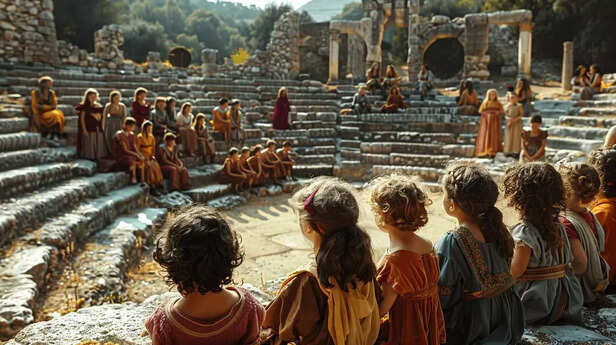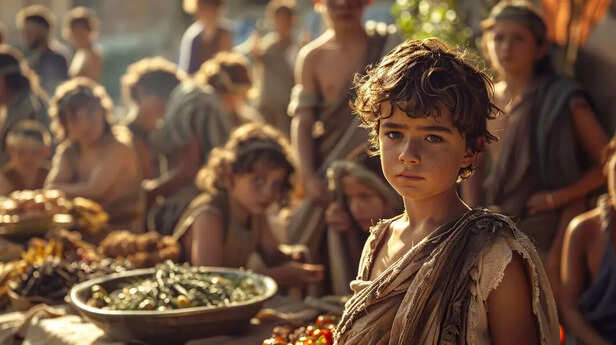Who Were the Original Indians? New Research Reveals the Story
Nidhi | Jan 01, 2025, 17:27 IST
Mohenjodaro
Explore the fascinating story of India's ancestry, a genetic mosaic shaped by ancient hunter-gatherers, Iranian farmers, and Eurasian pastoralists. Recent research reveals how migrations and cultural exchanges over millennia have woven the rich tapestry of India’s diverse population, offering new insights into the country’s evolutionary history.
India’s ancestry is like an ancient tapestry, woven with threads from countless journeys, migrations, and cultural exchanges. Imagine a land where the footsteps of hunter-gatherers echo from 50,000 years ago, mingling with the whispers of Iranian farmers who brought the secrets of cultivation, and the bold strides of Eurasian pastoralists spreading languages and ideas. Recent genetic research has uncovered this captivating story, revealing India not just as a geographical entity but as a living, breathing crossroads of human evolution. It’s a tale of adaptation, resilience, and the incredible diversity that forms the essence of what it means to be Indian.

A comprehensive study analyzing 2,762 high-coverage genomes from individuals across various regions of India has identified three primary ancestral groups contributing to the modern Indian gene pool:

The Indus Valley Civilization (IVC), one of the world's earliest urban cultures, thrived in the northwestern regions of South Asia around 3300 to 1300 BCE. Genetic studies of remains from IVC sites, such as Rakhigarhi, indicate that the inhabitants were primarily a mixture of ancient Iranian farmer-related ancestry and indigenous South Asian hunter-gatherers, with little to no contribution from Eurasian Steppe pastoralists.
This suggests that the major influx of Steppe pastoralist ancestry into the Indian gene pool occurred after the decline of the IVC, aligning with the proposed timeline of Indo-European language dissemination in the region.

The blending of these ancestral groups led to the formation of two major ancestral components in the Indian population:
These genetic findings have profound implications for understanding the demographic history of India:

While significant progress has been made in unraveling the genetic history of India, challenges remain:
The question of "Who were the original Indians?" does not have a singular answer. The genetic evidence points to a complex tapestry woven from multiple ancestral threads over millennia. The interplay of ancient hunter-gatherers, early agriculturalists, and migrating pastoralists has shaped the diverse and dynamic population of India today.
As research continues and more data emerges, our understanding of India's genetic heritage will become even more nuanced, offering deeper insights into the journeys, interactions, and adaptations that have defined the subcontinent's human history.
The Ancestral Components of the Indian Gene Pool

Culture
A comprehensive study analyzing 2,762 high-coverage genomes from individuals across various regions of India has identified three primary ancestral groups contributing to the modern Indian gene pool:
- South Asian Hunter-Gatherers (AASI - Ancient Ancestral South Indians): These are the earliest known inhabitants of the Indian subcontinent, whose presence dates back at least 50,000 years. They are believed to have a connection to now-extinct human relatives, possibly Denisovans,
- Ancient Iranian Farmers: Around 9,000 years ago, agricultural communities from the region corresponding to present-day Iran migrated into the Indian subcontinent. These migrants brought with them farming practices, significantly influencing the development of settled agricultural societies in India.
- Eurasian Steppe Pastoralists: Approximately 4,000 years ago, nomadic herders from the Eurasian Steppe, associated with the spread of Indo-European languages, migrated into India. Their arrival introduced new cultural and linguistic elements, further diversifying the genetic landscape.
The Indus Valley Civilization and Genetic Insights

Dholavira East Gate
The Indus Valley Civilization (IVC), one of the world's earliest urban cultures, thrived in the northwestern regions of South Asia around 3300 to 1300 BCE. Genetic studies of remains from IVC sites, such as Rakhigarhi, indicate that the inhabitants were primarily a mixture of ancient Iranian farmer-related ancestry and indigenous South Asian hunter-gatherers, with little to no contribution from Eurasian Steppe pastoralists.
This suggests that the major influx of Steppe pastoralist ancestry into the Indian gene pool occurred after the decline of the IVC, aligning with the proposed timeline of Indo-European language dissemination in the region.
Formation of Ancestral North and South Indians

Ancient Culture
The blending of these ancestral groups led to the formation of two major ancestral components in the Indian population:
- Ancestral North Indians (ANI): A genetic amalgamation of Indus Valley inhabitants and Eurasian Steppe pastoralists. The ANI component is more prevalent in northern and western parts of India and is associated with Indo-European language speakers.
- Ancestral South Indians (ASI): Descendants of Indus Valley populations who migrated southward, mixing further with indigenous South Asian hunter-gatherers. The ASI component is more prominent in southern India and among Dravidian language speakers.
Implications for Understanding Indian Demography
- Cultural and Linguistic Diversity: The intricate genetic landscape correlates with the vast array of languages, traditions, and social structures observed across India. The migrations and subsequent intermingling of diverse groups have contributed to the rich cultural mosaic present today.
- Caste and Social Stratification: Genetic studies reveal that endogamy (marriage within specific social groups) became prevalent in India around 2,000 years ago, leading to distinct genetic signatures among different castes and communities. This practice has reinforced social stratification over centuries.
- Health and Disease Research: Understanding the genetic diversity and ancestral components of the Indian population is crucial for medical research, particularly in identifying genetic predispositions to certain diseases and developing personalized healthcare strategies.
Challenges and Future Directions

Ancient India
While significant progress has been made in unraveling the genetic history of India, challenges remain:
- Underrepresentation in Genetic Studies: Despite recent efforts, many Indian communities, especially indigenous and marginalized groups, remain underrepresented in genetic research. Comprehensive sampling across all regions and communities is essential for a complete understanding.
- Ethical Considerations: Conducting genetic research in a culturally and socially sensitive context like India requires careful ethical considerations, including informed consent, data privacy, and the potential implications of findings on social dynamics.
- Interdisciplinary Approaches: Integrating genetic data with archaeological, linguistic, and anthropological evidence will provide a more holistic understanding of India's past, bridging the gap between scientific findings and historical narratives.
Who were the original Indians ?
As research continues and more data emerges, our understanding of India's genetic heritage will become even more nuanced, offering deeper insights into the journeys, interactions, and adaptations that have defined the subcontinent's human history.
